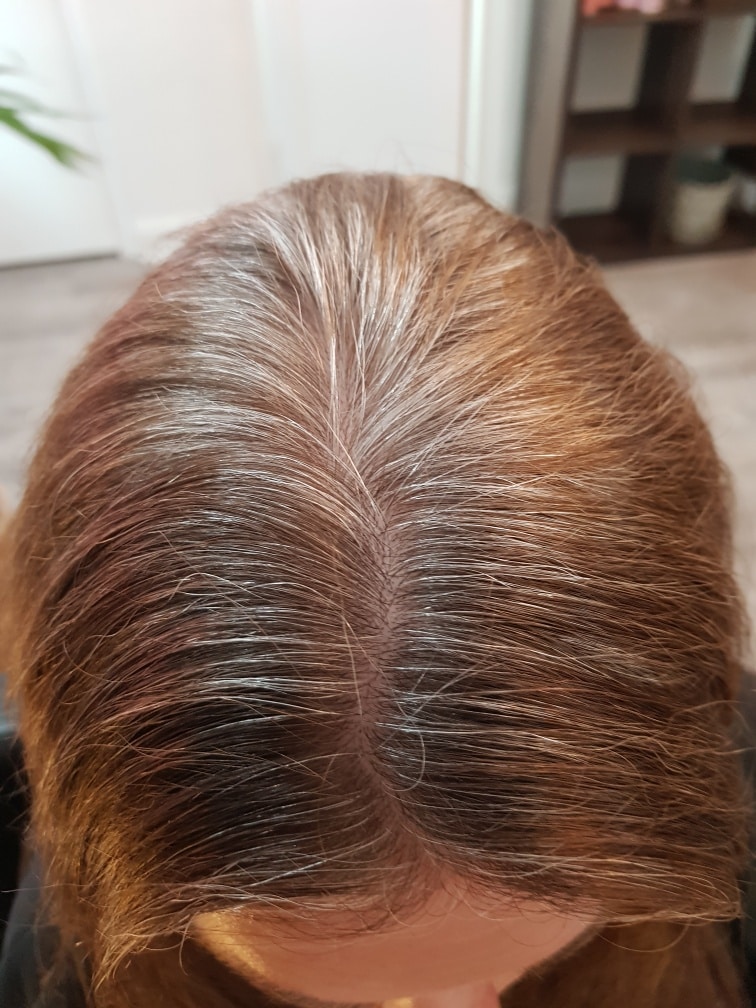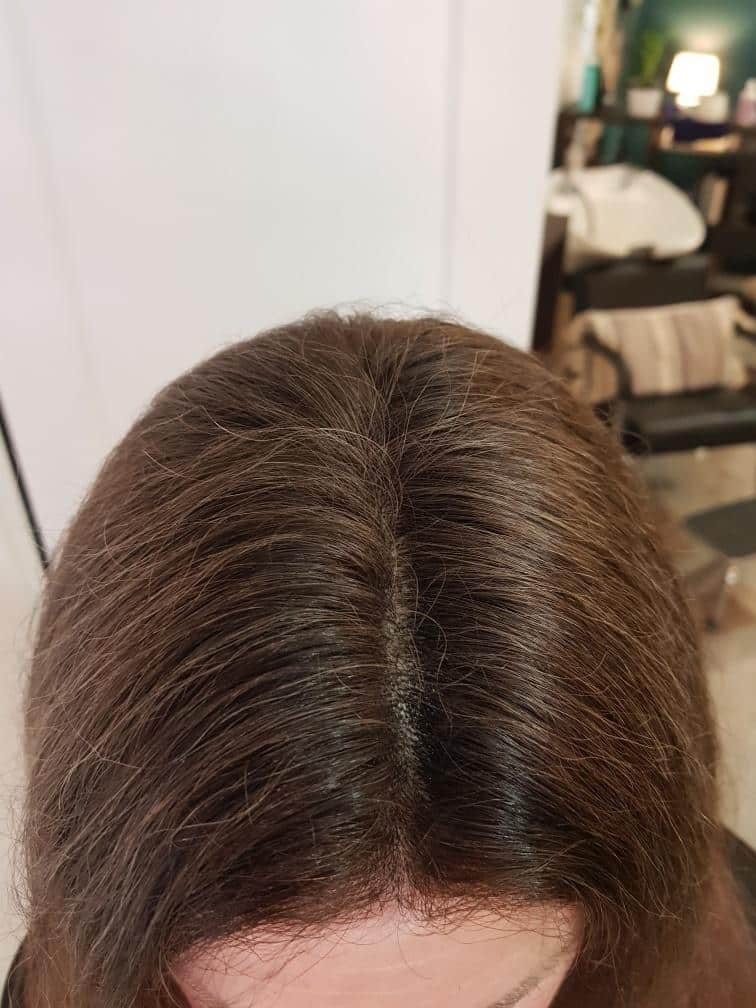The Case:
- With Hashimoto’s and hypothyroidism she knew she had to watch out for triggers
- She worried that the toxic chemicals in her hair dye could become a trigger but she wasn’t ready to go gray
- She looked at organic options, but realized they all STILL had harsh chemicals and the substitutes were even worse.
Full disclosure, this week’s case is about ME and my struggle to find a healthy way to stave off the grays without triggering and worsening my Hashimoto’s. I was determined to find an answer and I did.
The Investigation
I was shocked to discover that there are many hair dye options that present themselves as a healthy option but that still contain many chemicals. Several ‘ammonia free’ options have chemicals that could be potentially worse. And, the addition of ‘organic’ to a label or name does not mean there aren’t chemicals, it just means some of the ingredients are organic. How frustrating!
Luckily, I did find a solution that is safer and still works. It’s called Hairprint. Like with most things, it has its pros and cons. To find out a bit more about the product itself, I invited Jennifer Barker on the show.
Jennifer has been in the hair industry for over 20 years. She’s a hairdresser and colorist and now she’s the director of customer experience at Hairprints.
Are Hair Dyes Toxic?
Jennifer explains how conventional hair dye works and why so many hair dyes contain potentially harmful toxins.
Ammonia or nanolumens are used in many hair dyes to pull apart the layers of the hair protein to give the dye access to the hair shaft. Ammonia-free dyes often use chemicals like hydrogen peroxide and PPD (Paraphenylenediamine) to do the same thing. It’s worth noting that PPD is so potentially harmful that it is banned in Canada and the EU.
This chemical-process compromises the whole structure of the hair internally and externally. Chemicals may also seep into your bloodstream during the dying process if the chemicals are on the scalp.
These toxins can harm the immune system, the respiratory system, the liver, the kidneys, and can trigger serious allergic reactions.
Can Hair Dye be Triggering for Autoimmune?
Anyone with an autoimmune disease like Hashimoto’s or with any type of chronic illness may be more sensitive to the toxins in conventional hair dyes and the toxins can be triggers for any autoimmune disease. For some, they will experience itchiness or hives right away or a few hours later. Sometimes, it’s cumulative so it may not happen the first few times someone uses a hair dye and then the third or fourth time there’s a reaction. The reaction can differ too. It might be itchiness, a rash, or even hives.
It may also be when the immune system is already being challenged by another trigger. In some cases, like in mine, there may not be a direct scalp reaction but the accumulation of toxins in the body can create further immune confusion and therefore further attack of our organs by our own immune systems.
The Truth about Organic Hair Dyes
I often see organic hair dyes and I think it must be better than the conventional options but Jennifer says that it’s a bit misleading. She says that the FDA doesn’t define, recognize, or regulate the term ‘organic’ in the personal care industry. This means that companies can add natural ingredients and call their hair dye organic but does not mean there aren’t chemicals in the dye. Often the added botanical or organic elements have nothing to do with the dying process; they are just in addition to the usual chemicals in a conventional hair dye. It’s basically marketing, according to Jennifer.
How Does Hairprint Work?
Hairprint really is a different process than regular hair dye – in fact, Jennifer doesn’t like to put it in the same category and I can see why.
It has 8 food-grade ingredients and the key ingredient is melanin from velvet beans. Melanin is what determines the color of our skin and eyes.
The process of Hairprint is more like biomimicry than dye. It takes unpigmented hair (gray hair) and puts the melanin back into the hair. It does this without the harsh chemicals required to open up the hair follicles and hair shaft but this means that the process does take a bit more care.
The Hairprint Process
There is a learning curve when it comes to using Hairprint and it does take a bit of preparation. There can’t be any residue or buildup on the hair before the treatment. So, Jennifer says it’s best to pause all conventional hair care products for seven days. It’s known as the seven day cleanse.
The next step is to use the chelating shampoo. This may need to be repeated as many as 4 times over the course of a week in order to remove any residual silicones, calcium and other minerals (more prevalent if you use hard water), chlorine, or excess sebum. The chelating shampoo draws the impurities out.
After that, there are three steps to the process – the prepare, the restore, and the complete. The ‘Prepare’ stage is a pre-treatment shampoo that you leave on for 5 – 25 minutes depending on how sensitive your scalp is (everyone is different but the standard duration is 15 minutes). This softens the hair cuticle. If you have color treated hair, you only need to treat the untreated hair during step one.
Step two is ‘Restore’ which is when you restore the pigment of gray hairs. You can choose between pigment that is light brown or dark brown. These contain the same ingredients, they just have different ratios of pigment. You are mixing it together and once you see it turn a reddish color, you want to get it on your hair within 6 minutes of mixing. If you’re doing your whole head then put it everywhere but you can just do your roots if that’s all that needs coverage. Allow it to process for 15 to 20 minutes and then repeat. For those who are more than 30% gray, you would do this step an additional 3rd time after which you would rinse is out.
If you are transitioning from conventional hair dye to Hairprint, you will want to make sure that you are only applying the mixture to your virgin hair. If you apply it to previously colored hair, you will not have a uniform color. Instead, apply shea butter to the previously colored hair to avoid the Hairprint color from getting on to the previously colored hair. Over time, your previously colored hair will grow out and you will be able to skip the shea butter application.
The final step is ‘Complete’. Some people who are used to coloring their hair compare this step to applying toner but what it’s actually doing is helping push the pigment further into the hair cuticle. This step warms up the color by increasing the hair’s light reflection. It also helps with the longevity of the color.
Can You Apply Hairprint to Henna Treated Hair?
Don’t be tricked into thinking that because Henna is natural, it’s not dye. There are two types of Henna – the kind you use for body art which is pure and and the kind sold as a hair color treatment which is compound. If you are using the hair treatment, it may contain chemicals like PPD, so you will want to avoid applying Hairprint directly onto this color treated hair. Jennifer says it’s best to allow the Henna treated hair to grow out instead.
My Experience with Hairprint
Like many people, I thought it was going to be impossible to cover up my grays without chemicals. I had worked so hard to avoid having any chemicals in my food and my home and I hated to think that coloring my hair was the one place my healthy plan might be compromised. I thought I might be able to avoid the chemicals getting into my system by treating my scalp with oils beforehand but then the dyes wouldn’t take. And, while the conventional dye was doing the job of covering the grays for a few weeks after each treatment, it left my hair feeling dry and unhealthy.
I decided that the commitment to dying my roots every 4-6 weeks for the rest of my life was too much compromise. With Hashimoto’s I didn’t want there to be any avoidable chemicals in my life that could cause a flare up.
I started researching options and stumbled on Hairprint. I was skeptical. Was it a scam? Would it work? Was it truly a chemical-free option? And, after watching videos about the process, I wondered if it would be worth all of the work.
I decided to give it a try and have been so pleased with the results. The proof is in the images I’ve shared below. You can see the grays in my roots and how nicely they are covered up after the Hairprint process.
I had never colored my own hair and I was nervous about doing it. There are a few hairdressers who can apply Hairprint and I was so excited to discover one that wasn’t too far away (much further than my previous hairdresser but still a doable distance).
I share my entire experience of switching to Hairprint in this podcast but I will say that the best part is that I no longer have to endure the odor of chemicals when I go to the salon! And, I didn’t have to give up covering up my grays.


Eliminating Health Mysteries
For me, finding a way to remove even more chemicals from my lifestyle without compromise was another way to avoid health issues related to Hashimoto’s. Could this be the missing clue for you or someone in your life?
Links:
Resources mentioned
Thanks to my guest Jennifer Barker. You can connect with her like I did through the Hairprint website. https://www.myhairprint.com/
Related Podcast Episodes:
[Ask Inna] Answers to All Your Hashimoto’s Questions [Ask Inna] More Answers to Your Hashimoto’s Questions (Part 2) Solving the Autoimmunity Mystery w/ Inna Topiler 5 Reasons You’re Not Losing WeightThanks for Listening
If you like what you heard, please rate and review this podcast. Every piece of feedback not only helps me create better shows, it helps more people find this important information.
Never miss an episode – Subscribe NOW to Health Mysteries Solved with host, Inna Topiler on Apple Podcasts, Spotify, Stitcher or Google Podcasts and remember to rate and review the show!
Find out more at https://innatopiler.com
